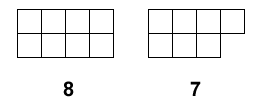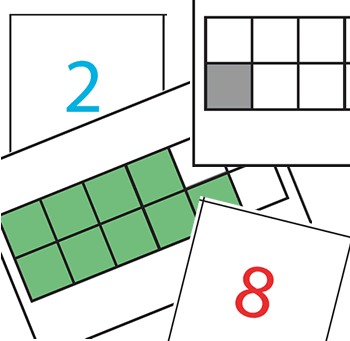Copyright © University of Cambridge. All rights reserved.
'Even and Odd' printed from https://nrich.maths.org/
Show menu
Why do this problem?
This problem is designed to be worked on in groups so that lots of examples are generated. It offers opportunities for children to consolidate counting and addition, as well as giving them a way of 'seeing' odd and even numbers. The aim is for learners to be able to generalise the results of adding pairs of numbers together in terms of odds and evens.
Possible approach
This activity is best done with the whole class, split into four smaller groups. One group will need a copy of these black cards, one will need the blue cards, one the green cards and the fourth group will need the red cards.

Draw the whole class together and ask one group to choose two of their Multilink numbers. Hold up the two blocks and ask how they could add them together. How many cubes would we have altogether? Invite children to come up and demonstrate. They may come up with different ways to join the two blocks so spend some time exploring this. Which way makes it easier to count the number of cubes? Listen out for explanations which focus on counting in twos, so it might be easiest to try to make blocks which are based on two 'rows' of Multilink. For example, adding 9 and 11:


Gather several examples on the board and ask children what they notice. What is the same about all the examples? Listen out for observations about one of the numbers having a square 'sticking out' and one of the numbers forming a rectangular block which doesn't have a 'sticking out' square. If the children do not already know the vocabulary of odds and evens, then introduce this to them. What kind of number is 15? Encourage children to articulate that an odd number and an even number added together makes an odd number (or that an odd number can be made from one odd number and one even number added together).
Repeat this process with an even number, for example 12. What two numbers could have been added together to make 12? Gather examples on the board and encourage the generalisation in the same way: an odd number added to an odd number makes an even number, and an even number added to an even number makes an even number (or an even number can be made from two odd numbers added together or two even numbers added together).
Key questions
Possible extension
You could extend this challenge using a simplified version of Make 37: If you are only allowed to use 1s, 3s and 5s (but as many of each as you like), can you find all the ways to make 12 using four numbers? Can you find all the ways to make 13 using four numbers? This will allow you to assess whether they have fully understood the generalisation.
Possible support
If there are enough Multilink cubes, some children may find it easier to keep the models they make rather than making drawings on paper.
